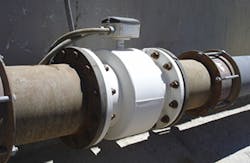Fact or myth: Flowmeter straight run ‘rule of thumb’
Have you ever heard the "rule of thumb" to install flowmeters with 10 diameters of straight run upstream of the flowmeter and 5 diameters of straight run downstream of the flowmeter? Is this a fact or a myth? I suggest that there is a bit of both. Let me explain.
In general, flowmeter manufacturers test their flowmeters downstream of different upstream piping configurations where the upstream fittings tend to distort the velocity profile. Common configurations include installing the flowmeter downstream of a reducer, downstream of an elbow, downstream of two elbows, downstream of two elbows out of plane, and the like. The flowmeter can be installed at different distances downstream of the fittings to determine how much straight run is required to sufficiently attenuate the velocity profile distortion so as to not affect the flow measurement.
READ ALSO: How to Develop a Good Velocity Profile Without Installing Straight Run
For example, a flowmeter located 2 diameters of straight run downstream of an elbow may exhibit significant measurement error while the same flowmeter located 8 diameters downstream of the same elbow may measure accurately. In this example, the flowmeter would measure accurately when installed with 10 diameters of upstream straight run (per the rule of thumb).
However, the same flowmeter may require 30 diameters of upstream straight run to measure accurately downstream of two elbows out of plane — a configuration that tends to generate more velocity profile distortion. Installing the flowmeter 10 diameters downstream of two elbows out of plane (per the rule of thumb) would cause the flowmeter to not measure accurately.
On the other hand, some flowmeters measure accurately with no upstream straight run — regardless of the upstream piping configuration.
Therefore, each flowmeter has its own unique straight run requirements for various upstream piping configurations. Flowmeters should be installed in accordance with these unique requirements for that flowmeter and not a rule of thumb.
David W. Spitzer
David W. Spitzer is a regular contributor to Flow Control magazine and a principal in Spitzer and Boyes, LLC offering engineering, seminars, strategic, marketing consulting, distribution consulting and expert witness services for manufacturing and automation companies. Spitzer and Boyes is also the publisher of the Industrial Automation INSIDER. Spitzer has more than 40 years of experience and has written over 10 books and 300 articles about flow measurement, instrumentation and process control. He can be reached at 845 623-1830 or via www.spitzerandboyes.com. Click on the "Products" tab to find his Consumer Guides to various flow and level measurement technologies.
David W. Spitzer
David W Spitzer’s new book Global Warming (aka Climate Change): An Understandable Data-Driven Explanation and Pathway to Mitigation (Amazon.com) adds to his over 500 technical articles and 10 books on flow measurement, instrumentation, process control and variable speed drives. David offers consulting services and keynote speeches, writes/edits white papers, presents seminars, and provides expert witness services at Spitzer and Boyes LLC (spitzerandboyes.com or +1.845.623.1830).



